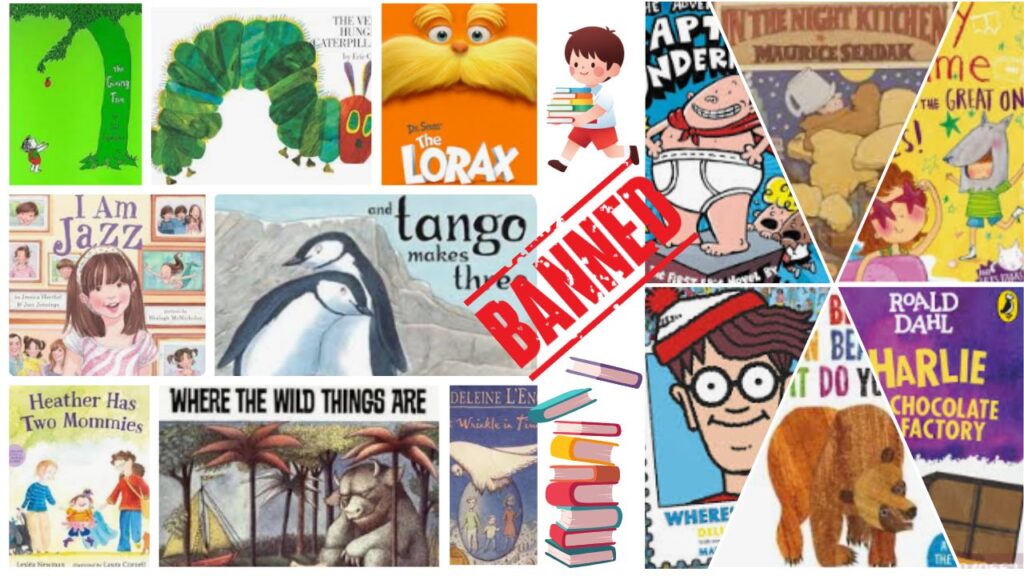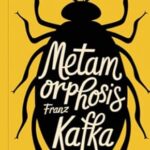25 Children’s Books You Won’t Believe Were Banned
Books open doors to imagination, kindness, and curiosity. We read them to children to help them dream, to laugh, and to understand the world. Yet, surprisingly, even some of the most beloved picture books have faced bans and challenges.
For instance, The Very Hungry Caterpillar has been banned from certain schools for supposedly “promoting obesity and unrealistic realities of eating lots of food.” And it’s not alone — from stories about penguin families to wild adventures, many innocent-looking children’s books have been challenged for reasons ranging from family diversity and imagination to themes adults found “too bold” for little readers.
1. And Tango Makes Three by Peter Parnell & Justin Richardson
This sweet picture book tells the real story of two male penguins, Roy and Silo, who raise a chick together in New York’s Central Park Zoo.
It was banned and challenged in several schools for showing same-sex parents.
Some people thought it was “not suitable” for children, but many families and teachers see it as a story about love, care, and family in all forms.
Today, it’s often praised for helping children understand that families can look different — but love remains the same.
2. I Am Jazz by Jazz Jennings & Jessica Herthel
“I Am Jazz” is based on the true story of Jazz Jennings, a transgender girl who knew from a young age that she was different.
The book gently explains what it means to be transgender in words children can understand.
It has been banned in several schools and libraries for “discussing gender identity” — a topic some parents believe is too mature for children.
Supporters say it helps promote empathy and acceptance for all children, no matter who they are.
3. Heather Has Two Mommies by Lesléa Newman
Heather loves her two mothers and enjoys going to preschool just like everyone else.
Her story is simple — she plays, learns, and makes friends — yet it sparked strong reactions when it was first published in 1989.
The book was banned in many libraries and schools for openly portraying a family with same-sex parents.
Over time, it became a symbol for inclusion and the right for children to see their families reflected in books.
4. The Giving Tree by Shel Silverstein
This beloved classic follows a boy and a tree who share a lifetime of giving and love.
As the boy grows up, he takes more and more from the tree until nothing is left but a stump — yet the tree still offers what she can.
Some critics argued that the book encourages selfishness or teaches unhealthy sacrifice.
Others see it as a touching story about unconditional love and the joy of giving.
Despite the debates, its message continues to move both children and adults around the world.
5. Where the Wild Things Are by Maurice Sendak
A little boy named Max is sent to his room after misbehaving — but his imagination takes him on an adventure to a land of wild monsters.
When first published in the 1960s, some libraries banned it for being “too dark” and “emotionally disturbing.”
Parents worried the monsters were too scary, and that Max’s defiance set a bad example.
But many child psychologists later praised the book for helping children explore feelings like anger and fear safely through imagination.
It remains one of the most celebrated picture books ever written.
6. The Lorax by Dr. Seuss
In this colorful tale, the Lorax “speaks for the trees” and warns about the damage caused by greed and pollution.
Some schools and communities banned it, claiming it was “anti-industry” and taught children to dislike business or logging.
But many see it as one of the first environmental stories for kids — a gentle reminder that nature needs our care and respect.
7. Brown Bear, Brown Bear, What Do You See? by Bill Martin Jr.
This simple, rhyming book teaches toddlers about animals and colors.
It was once banned in Texas schools — by mistake!
Officials confused the author with another Bill Martin who had written an adult political book about Marxism.
The mix-up was later corrected, but it remains one of the most unusual book bans in history.
8. In the Night Kitchen by Maurice Sendak
A dreamlike story about a boy named Mickey who falls into a magical kitchen and helps bakers prepare for the morning.
The book was banned in several libraries because Mickey is shown without clothes in a few illustrations.
Some adults found it inappropriate, but others saw it as innocent and imaginative — showing the natural curiosity of childhood.
Today it’s praised for its creativity and bold art.
9. Where’s Waldo? by Martin Handford
A fun search-and-find book that sends children on visual adventures to spot Waldo in huge, busy scenes.
It was banned in some libraries because one tiny drawing — hidden deep in a crowd — showed a woman sunbathing partially unclothed.
Despite this, children continue to love the challenge and excitement of finding Waldo everywhere he goes.
10. Captain Underpants (series) by Dav Pilkey
Two mischievous boys create a comic about a superhero in underwear who saves the day.
Schools banned it for potty humor, pranks, and “disrespecting authority.”
But author Dav Pilkey wrote it to make reluctant readers laugh — and read more.
He believes humor is a doorway to a love of reading, and millions of kids agree.
11. The Pain and the Great One by Judy Blume
This book tells the story of two siblings who argue about who is loved more by their parents.
It was challenged for showing “disrespect” and “rude behavior.”
But Judy Blume wanted children to see that jealousy and rivalry are normal parts of family life — and that love is shared, even when kids don’t see it.
12. The Wonderful Wizard of Oz by L. Frank Baum
Dorothy’s journey to Oz has delighted generations, but some schools once banned it for “ungodly” and “unrealistic” themes.
Critics said witches, magic, and talking animals promoted “unhealthy fantasy.”
Yet the story continues to inspire courage, kindness, and the belief that everyone already has what they need inside themselves.
13. Charlie and the Chocolate Factory by Roald Dahl
A magical tale of golden tickets and chocolate rivers.
The book was once banned for its “poor moral messages” and “dark humor.”
Some adults also objected to how certain characters were portrayed.
Still, children adore its wild imagination and lessons about greed, honesty, and humility.
14. The Witches by Roald Dahl
This spooky story describes witches who disguise themselves as ordinary women.
It was banned for being “too scary” and accused of portraying women negatively.
But many readers see it as a thrilling fantasy about bravery, intelligence, and outsmarting evil.
15. Harriet the Spy by Louise Fitzhugh
Harriet keeps a notebook filled with honest observations about everyone she knows.
When others find it, chaos follows.
It was banned for encouraging spying, lying, and disrespectful behavior.
Yet it teaches honesty, self-reflection, and the importance of understanding others’ feelings.
16. A Wrinkle in Time by Madeleine L’Engle
Meg and her friends travel through time and space to rescue her father.
The book was banned for its fantasy elements and accusations of “promoting witchcraft.”
Some thought it mixed science and religion in ways that were confusing for children.
But it’s now loved for its message about love conquering darkness and the power of individuality.
17. Bridge to Terabithia by Katherine Paterson
A tender story about friendship, imagination, and loss.
It was banned for dealing with death and for being “too sad.”
Others objected to the use of mild language or the idea of an imaginary world.
But it helps children understand grief and the healing strength of friendship.
18. Goosebumps (series) by R. L. Stine
These fun horror stories thrilled young readers in the ’90s.
Parents and schools banned them for being “too scary” or “inappropriate for kids.”
But the author’s goal was to make reading exciting — and to show that fear can be faced safely through stories.
19. Scary Stories to Tell in the Dark by Alvin Schwartz
Short, eerie folk tales paired with spooky illustrations.
It was one of the most banned books in American schools for being “too disturbing.”
Some adults worried about nightmares; others found the art too frightening.
But the stories also teach bravery and introduce folklore in memorable ways.
20. Julie of the Wolves by Jean Craighead George
A young girl named Miyax survives in the Arctic with the help of wolves.
The book was banned for “sexual references” and “mature themes.”
Still, it’s praised for its beautiful writing and message about respect for nature and animal life.
21. The Great Gilly Hopkins by Katherine Paterson
Gilly is a smart, tough foster child who dreams of finding her real mother.
The book faced bans for bad language and rebellious behavior.
But readers love its honesty — showing that love and family aren’t always perfect, but they can be found in unexpected places.
22. Roll of Thunder, Hear My Cry by Mildred D. Taylor
Set in 1930s Mississippi, this novel follows an African-American family facing racism and injustice.
It was banned for racial slurs and its raw depiction of discrimination.
Yet it remains a powerful story about dignity, strength, and standing up for what’s right.
23. The Call of the Wild by Jack London
A dog named Buck is stolen from home and forced to survive in the frozen Yukon.
It was banned for violence and “too much realism.”
But its story of survival and the pull between civilization and nature continues to move readers of all ages.
24. Harry Potter (series) by J. K. Rowling
Harry discovers he’s a wizard and attends Hogwarts School of Witchcraft and Wizardry.
The series was banned for “promoting witchcraft” and “dark magic.”
Despite that, it has inspired millions of children to believe in friendship, courage, and the triumph of good over evil.
25. Guess What? by Mem Fox & Vivienne Goodman
A playful, rhyming picture book about a cheerful woman named Daisy O’Grady — who turns out to be a witch.
It was challenged for “occult themes” and “inappropriate illustrations.”
Yet Mem Fox wrote it to celebrate curiosity and humor — showing that even witches can be fun, not frightening.
Why These Bans Matter
Most of these books were never meant to cause harm. They were written to help children laugh, think, and see the world differently. Banning them often comes from fear — fear of difference, imagination, or change. But books that challenge us often help us grow the most. They teach acceptance, courage, and empathy. And sometimes, the very stories adults try to hide are the ones children need most.



